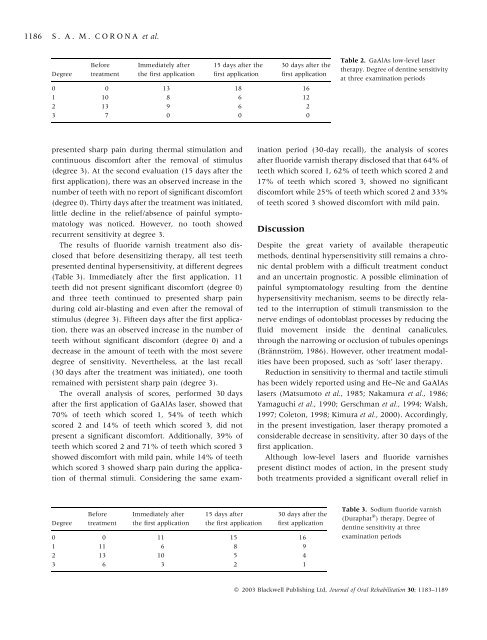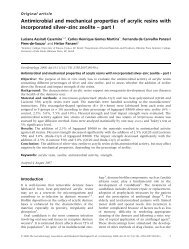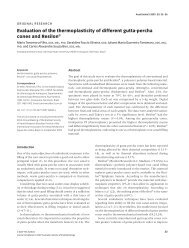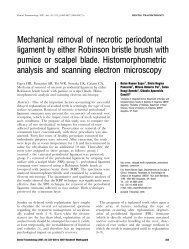Clinical evaluation of low-level laser therapy and fluoride varnish for ...
Clinical evaluation of low-level laser therapy and fluoride varnish for ...
Clinical evaluation of low-level laser therapy and fluoride varnish for ...
Create successful ePaper yourself
Turn your PDF publications into a flip-book with our unique Google optimized e-Paper software.
1186<br />
S. A. M. CORONA et al.<br />
Degree<br />
presented sharp pain during thermal stimulation <strong>and</strong><br />
continuous discom<strong>for</strong>t after the removal <strong>of</strong> stimulus<br />
(degree 3). At the second <strong>evaluation</strong> (15 days after the<br />
first application), there was an observed increase in the<br />
number <strong>of</strong> teeth with no report <strong>of</strong> significant discom<strong>for</strong>t<br />
(degree 0). Thirty days after the treatment was initiated,<br />
little decline in the relief/absence <strong>of</strong> painful symptomatology<br />
was noticed. However, no tooth showed<br />
recurrent sensitivity at degree 3.<br />
The results <strong>of</strong> <strong>fluoride</strong> <strong>varnish</strong> treatment also disclosed<br />
that be<strong>for</strong>e desensitizing <strong>therapy</strong>, all test teeth<br />
presented dentinal hypersensitivity, at different degrees<br />
(Table 3). Immediately after the first application, 11<br />
teeth did not present significant discom<strong>for</strong>t (degree 0)<br />
<strong>and</strong> three teeth continued to presented sharp pain<br />
during cold air-blasting <strong>and</strong> even after the removal <strong>of</strong><br />
stimulus (degree 3). Fifteen days after the first application,<br />
there was an observed increase in the number <strong>of</strong><br />
teeth without significant discom<strong>for</strong>t (degree 0) <strong>and</strong> a<br />
decrease in the amount <strong>of</strong> teeth with the most severe<br />
degree <strong>of</strong> sensitivity. Nevertheless, at the last recall<br />
(30 days after the treatment was initiated), one tooth<br />
remained with persistent sharp pain (degree 3).<br />
The overall analysis <strong>of</strong> scores, per<strong>for</strong>med 30 days<br />
after the first application <strong>of</strong> GaAlAs <strong>laser</strong>, showed that<br />
70% <strong>of</strong> teeth which scored 1, 54% <strong>of</strong> teeth which<br />
scored 2 <strong>and</strong> 14% <strong>of</strong> teeth which scored 3, did not<br />
present a significant discom<strong>for</strong>t. Additionally, 39% <strong>of</strong><br />
teeth which scored 2 <strong>and</strong> 71% <strong>of</strong> teeth which scored 3<br />
showed discom<strong>for</strong>t with mild pain, while 14% <strong>of</strong> teeth<br />
which scored 3 showed sharp pain during the application<br />
<strong>of</strong> thermal stimuli. Considering the same exam-<br />
Degree<br />
Be<strong>for</strong>e<br />
treatment<br />
Be<strong>for</strong>e<br />
treatment<br />
Immediately after<br />
the first application<br />
Immediately after<br />
the first application<br />
15 days after the<br />
first application<br />
15 days after<br />
the first application<br />
30 days after the<br />
first application<br />
0 0 13 18 16<br />
1 10 8 6 12<br />
2 13 9 6 2<br />
3 7 0 0 0<br />
ination period (30-day recall), the analysis <strong>of</strong> scores<br />
after <strong>fluoride</strong> <strong>varnish</strong> <strong>therapy</strong> disclosed that that 64% <strong>of</strong><br />
teeth which scored 1, 62% <strong>of</strong> teeth which scored 2 <strong>and</strong><br />
17% <strong>of</strong> teeth which scored 3, showed no significant<br />
discom<strong>for</strong>t while 25% <strong>of</strong> teeth which scored 2 <strong>and</strong> 33%<br />
<strong>of</strong> teeth scored 3 showed discom<strong>for</strong>t with mild pain.<br />
Discussion<br />
Despite the great variety <strong>of</strong> available therapeutic<br />
methods, dentinal hypersensitivity still remains a chronic<br />
dental problem with a difficult treatment conduct<br />
<strong>and</strong> an uncertain prognostic. A possible elimination <strong>of</strong><br />
painful symptomatology resulting from the dentine<br />
hypersensitivity mechanism, seems to be directly related<br />
to the interruption <strong>of</strong> stimuli transmission to the<br />
nerve endings <strong>of</strong> odontoblast processes by reducing the<br />
fluid movement inside the dentinal canalicules,<br />
through the narrowing or occlusion <strong>of</strong> tubules openings<br />
(Brännström, 1986). However, other treatment modalities<br />
have been proposed, such as ‘s<strong>of</strong>t’ <strong>laser</strong> <strong>therapy</strong>.<br />
Reduction in sensitivity to thermal <strong>and</strong> tactile stimuli<br />
has been widely reported using <strong>and</strong> He–Ne <strong>and</strong> GaAlAs<br />
<strong>laser</strong>s (Matsumoto et al., 1985; Nakamura et al., 1986;<br />
Yamaguchi et al., 1990; Gerschman et al., 1994; Walsh,<br />
1997; Coleton, 1998; Kimura et al., 2000). Accordingly,<br />
in the present investigation, <strong>laser</strong> <strong>therapy</strong> promoted a<br />
considerable decrease in sensitivity, after 30 days <strong>of</strong> the<br />
first application.<br />
Although <strong>low</strong>-<strong>level</strong> <strong>laser</strong>s <strong>and</strong> <strong>fluoride</strong> <strong>varnish</strong>es<br />
present distinct modes <strong>of</strong> action, in the present study<br />
both treatments provided a significant overall relief in<br />
30 days after the<br />
first application<br />
0 0 11 15 16<br />
1 11 6 8 9<br />
2 13 10 5 4<br />
3 6 3 2 1<br />
Table 2. GaAlAs <strong>low</strong>-<strong>level</strong> <strong>laser</strong><br />
<strong>therapy</strong>. Degree <strong>of</strong> dentine sensitivity<br />
at three examination periods<br />
Table 3. Sodium <strong>fluoride</strong> <strong>varnish</strong><br />
(Duraphat Ò ) <strong>therapy</strong>. Degree <strong>of</strong><br />
dentine sensitivity at three<br />
examination periods<br />
ª 2003 Blackwell Publishing Ltd, Journal <strong>of</strong> Oral Rehabilitation 30; 1183–1189






